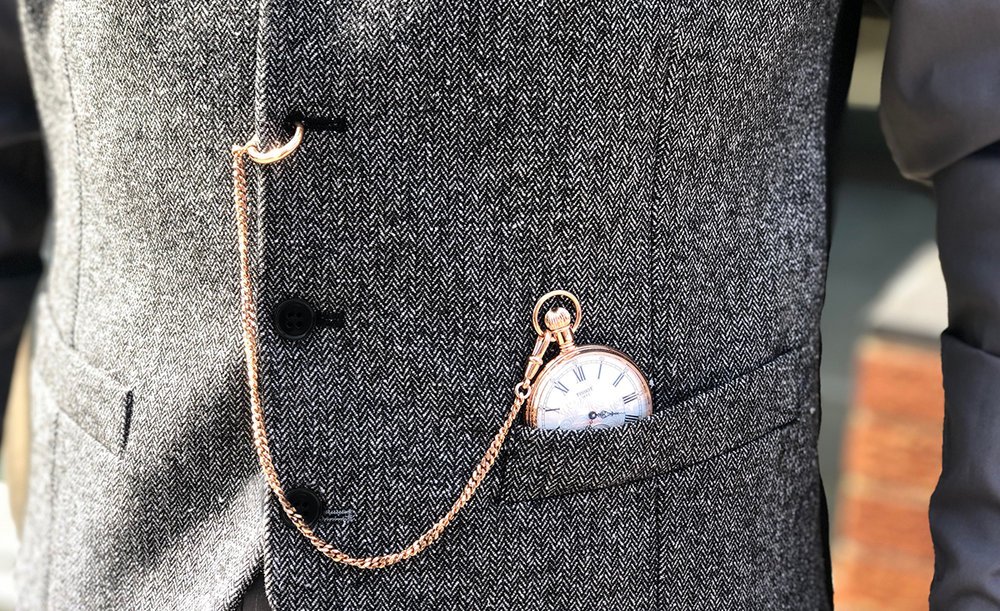History of Albert Chains – Sell Your Albert Chain with Us
The Definitive Guide to Albert Chains: History, Value & Collecting
Discover the elegance and craftsmanship of Victorian era's most sophisticated watch accessory
Have an Albert Chain to Sell? Looking to Buy One?
Contact us directly via WhatsApp for immediate assistance with buying or selling Albert Chains.
Albert Chains stand as one of the most elegant and sophisticated accessories from the Victorian era. Named after Prince Albert, husband of Queen Victoria, these exquisite chains were designed to secure pocket watches while simultaneously serving as a statement of style, status, and refinement.

The Origins & History of Albert Chains
The Albert Chain emerged in the early Victorian period, gaining its name from Prince Albert (1819-1861), the beloved husband of Queen Victoria. Prince Albert was known for his impeccable style and often wore a gold chain to secure his pocket watch to his waistcoat. Following his untimely death in 1861, the style became immensely popular as gentlemen sought to emulate his refined taste.
Prince Albert begins wearing a distinctive gold chain to secure his pocket watch, setting a trend among the aristocracy.
The style gains popularity among the upper classes, with jewelers beginning to create variations on the original design.
Following Prince Albert's death, the chains become widely known as "Albert Chains" and surge in popularity as a tribute to the Prince Consort.
The golden age of Albert Chains, with elaborate designs, multiple attachments, and various metals becoming available to different social classes.
Popularity begins to wane as wristwatches gradually replace pocket watches, though many continue to wear Albert Chains as a traditional accessory.
Albert Chains are highly sought after by collectors, historians, and enthusiasts of Victorian jewelry and horological accessories.
Design & Craftsmanship
The Albert Chain represents the pinnacle of Victorian craftsmanship, with each piece showcasing the meticulous attention to detail characteristic of the era. Master jewelers created these chains with extraordinary precision, often incorporating intricate patterns and decorative elements that demonstrated their technical skill.

The classic Albert Chain features several distinctive elements:
- T-bar: A horizontal bar designed to be inserted through a buttonhole of a waistcoat, securing the chain in place.
- Main Chain: The primary length of chain connecting the T-bar to the pocket watch.
- Drop Chain: A secondary, shorter chain that hung across the waistcoat, often holding a decorative fob, seal, or key.
- Swivel Clasp: A rotating mechanism that attached to the pocket watch, allowing it to be turned without twisting the chain.
- Fobs and Seals: Decorative attachments that could include family crests, fraternal symbols, or ornamental designs.
Chain Styles and Variations
Albert Chains were crafted in various styles, each with its own distinctive appearance and characteristics:
- Curb Chains: Featuring interlocking links that lie flat when extended, the most common style for Albert Chains.
- Belcher Chains: Characterized by round links that are larger than the wire diameter.
- Rope Chains: Designed to resemble twisted rope, offering an elegant, textured appearance.
- Fancy Link Chains: Incorporating decorative or ornate links, often with filigree or engraved details.
- Double Albert: Featuring two chains extending from the T-bar, with one for the watch and one for fobs or other accessories.
Materials & Craftsmanship
The value and status of an Albert Chain was often determined by its material, with precious metals being the most desirable:
Gold
The most prestigious Albert Chains were crafted from 9ct, 14ct, or 18ct gold. Yellow gold was most common, though rose gold and even white gold examples can be found in later pieces.
Silver
Sterling silver chains were popular among the middle classes, offering an elegant appearance at a more accessible price point. Many feature intricate engraving or decorative elements.
Rolled Gold
Also known as gold-filled, these chains featured a layer of gold bonded to a base metal, providing the appearance of solid gold at a fraction of the cost.
Platinum
Extremely rare, platinum Albert Chains emerged in the late Victorian and Edwardian periods, representing the height of luxury and exclusivity.
Social Significance
The Albert Chain transcended its practical purpose to become a powerful symbol of social status, taste, and personal identity in Victorian society. The quality, material, and complexity of a gentleman's chain communicated volumes about his position, wealth, and attention to detail.
The Albert Chain as a Status Symbol
In Victorian society, the Albert Chain served as an immediate visual indicator of a gentleman's standing. Gold chains with multiple fobs and accessories signaled wealth and prominence, while simpler silver or rolled gold versions were markers of respectability among the middle classes.
The chain's visibility—prominently displayed across a gentleman's waistcoat—made it an ideal vehicle for social signaling in an era obsessed with visual cues of status and propriety.
Beyond status, Albert Chains often carried personal significance through their attachments. Fobs might bear family crests, fraternal emblems, or commemorative designs marking significant life events. Some chains were presented as gifts to mark important occasions such as coming of age, professional achievements, or retirement.
Collecting Albert Chains
Today, Albert Chains are highly sought after by collectors of Victorian jewelry, horological accessories, and historical artifacts. Their combination of historical significance, craftsmanship, and aesthetic appeal makes them particularly desirable in the antique market.
Factors Affecting Value
When assessing the value of an Albert Chain, several key factors come into play:
- Material: Solid gold chains command the highest prices, with 18ct examples being particularly valuable. Silver chains, while less valuable than gold, can still be significant if they feature exceptional craftsmanship.
- Condition: Chains in excellent condition with minimal wear, intact clasps, and all original components will command premium prices.
- Craftsmanship: Finely crafted chains with intricate detailing, exceptional link work, or decorative elements are highly prized.
- Provenance: Chains with documented history, especially those associated with notable individuals or events, can be particularly valuable.
- Completeness: Full sets with original fobs, seals, or other attachments are more desirable than chains missing their original components.
- Hallmarks: Clearly legible hallmarks indicating maker, date, and metal content add significantly to a chain's value and authenticity.
Authentication & Identification
Authenticating an Albert Chain requires careful examination of several key elements:
- Hallmarks: Genuine period chains will bear appropriate hallmarks for their era and country of origin. British gold and silver chains should have clear hallmarks indicating metal purity, assay office, date letter, and maker's mark.
- Construction: Victorian craftsmanship is distinctive, with hand-finished elements and attention to detail that differs from modern reproduction pieces.
- Wear Patterns: Authentic period chains will show appropriate age-related wear, particularly at points of regular contact such as the T-bar and watch clasp.
- Link Design: The construction and design of links should be consistent with Victorian manufacturing techniques.
- Weight: Genuine gold and silver chains have appropriate weight for their metal and construction.
Expert Tip: Examining Hallmarks
When examining hallmarks on an Albert Chain, use a jeweler's loupe to identify all marks present. British gold items should bear the standard mark (lion passant for sterling silver or crown for gold), the assay office mark, a date letter, and often a maker's mark. The style and appearance of these marks evolved over time, providing valuable clues to a chain's age and authenticity.
Selling Your Albert Chain
If you own an Albert Chain and are considering selling, it's important to understand its potential value and find a reputable buyer who specializes in Victorian jewelry and watches.
At Mozeris Fine Antiques, we are actively seeking Albert Chains of all types and conditions. As specialists in Victorian jewelry with extensive knowledge of these historical pieces, we offer:
- Expert evaluation based on material, craftsmanship, condition, and historical significance
- Competitive offers reflecting current market values
- Simple, transparent selling process
- Quick payment options
- Professional handling of your valuable items
We Are Actively Buying Albert Chains
Whether you have a gold Albert Chain, silver Albert Chain, or any variation of this historic accessory, we would be delighted to provide a free, no-obligation evaluation. Our team of experts specializes in Victorian jewelry and can offer you the best possible value for your piece.
Don't wait – Albert Chains are in high demand among collectors!
Get Your Free Evaluation TodayHave an Albert Chain to Sell? Looking to Buy One?
Contact us directly via WhatsApp for immediate assistance with buying or selling Albert Chains.
Frequently Asked Questions
Genuine Victorian Albert Chains typically feature period-appropriate hallmarks, hand-finished details, and construction techniques consistent with 19th-century manufacturing. Look for hallmarks that include date letters corresponding to the Victorian era (1837-1901), appropriate wear patterns, and craftsmanship quality that reflects the handmade nature of period pieces.
A single Albert Chain features one main chain extending from the T-bar, typically used to secure a pocket watch. A double Albert Chain has two parallel chains extending from the T-bar—one for the pocket watch and another for fobs, seals, or other accessories. Double Alberts were generally more prestigious and allowed for more elaborate display of decorative elements.
Antique Albert Chains require gentle care to preserve their condition. Clean gold chains with a soft cloth and mild soap solution if necessary, avoiding harsh chemicals or ultrasonic cleaners. Silver chains may be gently polished with a specialized silver cloth, but avoid aggressive polishing that could remove patina or damage hallmarks. Store your chain flat in a soft pouch or jewelry box to prevent tangling or stress on the links.
While modern reproductions exist, authentic period Albert Chains are no longer manufactured in their original form. Some contemporary jewelers and watchmakers create chains inspired by Victorian designs, but these modern pieces typically lack the hand-craftsmanship and historical significance of genuine antique examples. Collectors generally prefer authentic period pieces for their historical value and superior craftsmanship.
The value of gold Albert Chains varies significantly based on factors including gold content (9ct, 14ct, or 18ct), length, weight, condition, craftsmanship quality, and presence of original fobs or attachments. Fine 18ct gold examples in excellent condition can command several thousand pounds, while 9ct chains in good condition might range from several hundred to over a thousand pounds. For a precise valuation of your specific piece, we recommend contacting us for a professional assessment.

